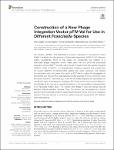Construction of a New Phage Integration Vector pFIV-Val for Use in Different Francisella Species
Tlapák, Hana
Köppen, Kristin
Rydzewski, Kerstin
Grunow, Roland
Heuner, Klaus
We recently identified and described a putative prophage on the genomic island FhaGI-1 located within the genome of Francisella hispaniensis AS02-814 (F. tularensis subsp. novicida-like 3523). In this study, we constructed two variants of a Francisella phage integration vector, called pFIV1-Val and pFIV2-Val (Francisella Integration Vector-tRNAVal-specific), using the attL/R-sites and the site-specific integrase (FN3523_1033) of FhaGI-1, a chloramphenicol resistance cassette and a sacB gene for counter selection of transformants against the vector backbone. We inserted the respective sites and genes into vector pUC57-Kana to allow for propagation in Escherichia coli. The constructs generated a circular episomal form in E. coli which could be used to transform Francisella spp. where FIV-Val stably integrated site specifically into the tRNAVal gene of the genome, whereas pUC57-Kana is lost due to counter selection. Functionality of the new vector was demonstrated by the successfully complementation of a Francisella mutant strain. The vectors were stable in vitro and during host-cell infection without selective pressure. Thus, the vectors can be applied as a further genetic tool in Francisella research, expanding the present genetic tools by an integrative element. This new element is suitable to perform long-term experiments with different Francisella species.
Dateien zu dieser Publikation
Keine Lizenzangabe

